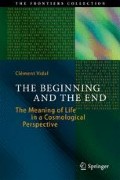Abstract
This chapter explores the far future of scientific simulations. It is argued that the path towards a simulation of an entire universe is an expected outcome of our scientific simulation endeavors. I describe the exponential increase of computing resources in a cosmological context, using Chaisson’s energy rate density complexity metric. Simulating the open-ended rise of levels of complexity in the physical, biological, and cultural realms is the challenge of simulating an entire universe. However, such an effort will require us to bridge the gaps in our knowledge of cosmic evolution, which is necessary to replay the tape of our and other possible universes. We elaborate the distinction between real-world and artificial-world modeling, the latter being at the heart of the artificial life and artificial cosmogenesis philosophy. We critically discuss the idea that we may be living in a computer simulation.
Access this chapter
Tax calculation will be finalised at checkout
Purchases are for personal use only
Author information
Authors and Affiliations
Corresponding author
Open Questions
Open Questions
The idea of simulating entire universes raises the issue of computational requirements:
-
What kind of computer would we need? What memory? What CPU speed? How many CPUs? Serial or parallel computing? What kind of software would we use? Where does the computer hardware exist? What power would it require?
These questions remain for further exploration (see e.g. Bostrom 2003 for discussion and references to some of these issues).
Researchers spend a lot of time and energy writing research projects, which after fierce competition are often rejected. In 2010, I wrote a research project called “Big history and our future: extension, evaluation and significance of a universal complexity metric” (Vidal 2010c). The core idea was to update and further research Chaisson’s (2001) energy rate density complexity metric. Unfortunately, despite good reviews and good academic support, it was not accepted. So I put the proposal on the website of the Evo Devo Universe community,Footnote 1 in the hope that it would be taken up and carried further. I was delighted to find that indeed this happened. Researchers later contacted John Smart and I to do further work on it. Some of the key research questions are:
-
Can we complete the curve to understand the past (early universe) and the future (acceleration of technology)?
-
What happens if we use this metric for the early universe? Chaisson starts the measurements with the birth of galaxies. But what about the energy rate density at the Big Bang era?
-
How well does the free energy rate density curve fits with Moore’s law? If we extrapolate those two trends, do they have any functional relation?
-
-
Does our universe have a reproductive dynamics? John Smart (2009) suggested so, but this needs further research. He conjectured that the general trend through time would be a U-shaped curve, with extremely high energy densities at the Big Bang era that decrease as the universe cools down. The energy rate density then starts to grow exponentially with the appearance of life. This energy pattern bears a striking resemblance to the energy pattern of the life cycle of a living organism from its birth through its maturity stage.
On February 3, 2010, alone in my office, I gave a seminar about cosmic embryogenesis (Vidal 2010d). Sad schizophrenia? No, cutting-edge technology. Indeed, colleagues of mine were attending from several corners of the world. How was it possible? Richard Gordon set up in the virtual environment Second Life an online International Embryo Physics course to stimulate efforts to reverse-engineer the process of embryological development. Thinking about biology and cosmology prompts the question:
-
To what extent can a biological view of the universe give us new insights?
In a landmark paper, Burbidge, Fowler, and Hoyle (1957) showed the mechanisms responsible for the progressive synthesis of heavy chemical elements, or stellar nucleosynthesis. The unchanging table of periodic elements we all learn at school gives an incorrect picture, because those elements have a history. It took billions of years for them to stabilize, although the formation of chemical elements is now largely stabilized. John Smart (2009) hypothesized that there might be a cosmic differentiation of chemical elements, which is now stabilized, analogous to cell differentiation in the development of multicellular organisms. Our blood cells don’t suddenly turn into neuron cells, just as hydrogen atoms don’t suddenly turn into gold. We can also see primordial nucleosynthesis as a progressive differentiation process, where protons and neutrons form atomic nuclei; then atomic nuclei and electrons form atoms, including isotopes of hydrogen, helium, and lithium.
Rights and permissions
Copyright information
© 2014 Springer International Publishing Switzerland
About this chapter
Cite this chapter
Vidal, C. (2014). The Future of Scientific Simulations. In: The Beginning and the End. The Frontiers Collection. Springer, Cham. https://doi.org/10.1007/978-3-319-05062-1_7
Download citation
DOI: https://doi.org/10.1007/978-3-319-05062-1_7
Published:
Publisher Name: Springer, Cham
Print ISBN: 978-3-319-05061-4
Online ISBN: 978-3-319-05062-1
eBook Packages: Physics and AstronomyPhysics and Astronomy (R0)

